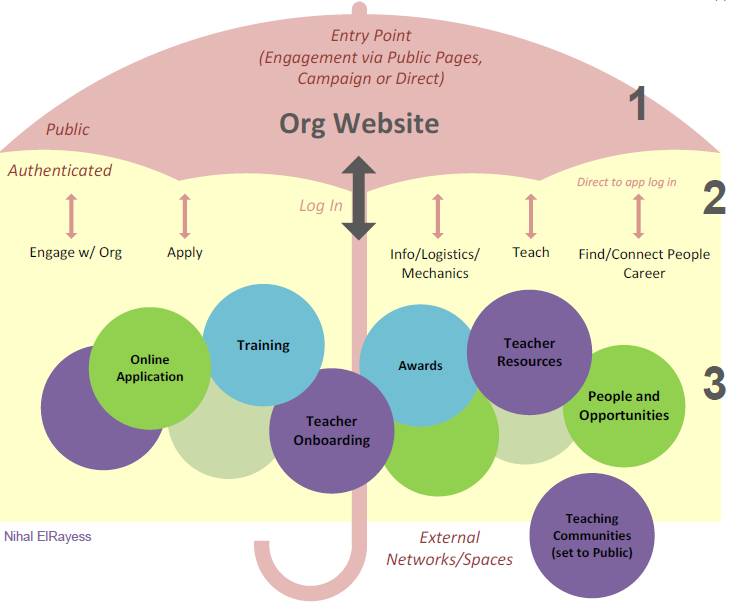Opportunity: Our team recognized our product wasn’t meeting our user needs despite regular feature additions and enhancements. We wanted to re-imagine our product model and vision while recognizing many known needs. We also wanted to decrease our dependency on building internal feature sets, instead leveraging a growing marketplace of compelling third party applications.
Solution: Akin to an app store, the rainforest analogy conceptualizes increasing depth as a user engages with public and then authenticated and personalized content. Ultimately the old platform was sunset and a brand new platform launched.
In the above image, 1, 2, 3 refer to the following:
- Overstory: Primary entry point for all audiences.
- Canopy: Personalized homepage tied to a user’s point in program, information, and choice. Surfaced relevant and recommended apps.
- Canopy Ecosystem: Individual apps lived here. Apps would focus on specific priorities (e.g., instructional resources, career). They would
vary in product ownership by business teams. Integration would vary with a bias toward light integration (SSO).
Disaggregate Analogy (Borrowing from Nature): Why loosely integrated apps?
In the rainforest most plant and animal life is […found…] in the leafy world known as the canopy. The canopy, which may be over 100 feet (30 m) above the ground, is made up of the overlapping branches and leaves of rainforest trees. Scientists estimate that 60-90 percent of life in the rainforest is found in the trees, making this the richest habitat for plant and animal life. […]
However, despite overlapping tree branches, canopy trees rarely interlock or even touch. Instead they are separated from one another by a few feet. Why the branches of these trees do not touch is still a mystery, but it is thought that it might serve as protection from infestations from tree-eating caterpillars and tree diseases like leaf blight. To survive, canopy dwellers must have the ability to negotiate these gaps by climbing, leaping, gliding, or flying.
Product Relevance: In today’s digital world, end users are used to disaggregated experiences including multiple profiles, jumping to diverse user interfaces and experiences, and using different tools for different purposes. Users do however appreciate fewer logins.
Relationships and Diversity Analogy: Meeting the expectation and demand of diverse needs, talent, and perspectives.
Rainforests have a high level of biological diversity or “biodiversity”. Biodiversity is the name for all living things—like plants, animals, and fungi—found in an ecosystem. Scientists believe that about half of the plants and animals found on Earth’s land surface live in rainforests.
Symbiotic relationships between species: Species in the rainforest often work together. In a symbiotic relationship, two different species benefit by helping each other—you can think of it as a partnership. For example, some plants produce small housing structures and sugar for ants. In return the ants protect the plants from other insects that want to feed on the plant’s leaves
Product Relevance: Our community of leaders is diverse in many ways, from classrooms ranging in grades and subject, to career leadership, to regional contexts, to diverse communities of students and families, to personal backgrounds. Our ecosystem of apps should support and play to the strengths of such a diverse community of individuals and students.
(Rainforest Information Source: http://kids.mongabay.com/lesson_plans/handout.html)

